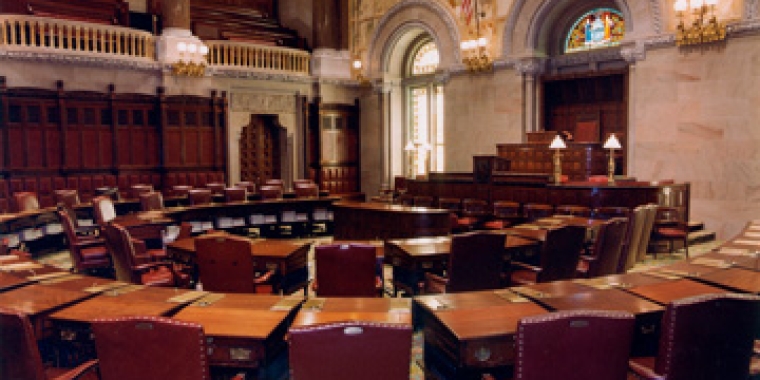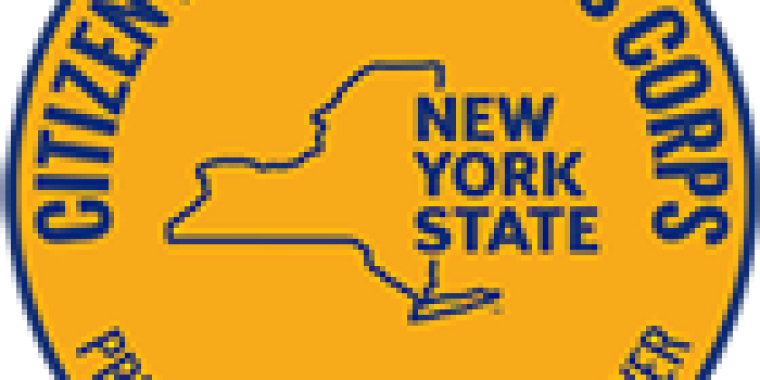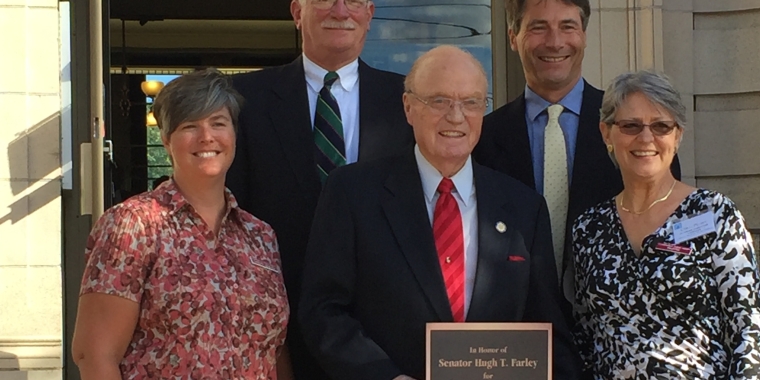
Welcome to Senator Farley's Kids Corner
Hugh T. Farley

Welcome to the Kids Corner! Being a father and a grandfather, I know that explaining how our State government works can sometimes be a difficult task. This page is designed to help children better understand the New York State Senate and the role I play in New York State Government. Filled with explanations of the role of a State Senator and how a bill becomes a law, this page also contains fun New York State facts and games.
WHAT IS THE STATE SENATE?
What is a Senator's role in State Government?
The Senate is part of the New York State Legislature, which is the governing body that creates laws for New York State. It has 63 members who represent 63 different parts (called "Senate Districts") of New York State, and Senators speak and act for people in those areas. If you live in Fulton and Hamilton Counties, and certain sections of Herkimer, Saratoga and Schenectady Counties, your Senator is Hugh T. Farley. This region is also called the 49th Senate District. If you visit http://www.nysenate.gov/district/49 you can see specifically what areas the 49th district cover.
Who are our State Senators?
A Senator may be a teacher, or a farmer, or a businessperson. A Senator may be a man or a woman, a father or a mother, married or unmarried. Like the people they represent, Senators come from a variety of backgrounds, races, and religions. Senator Farley is a husband and a father of three children as well as a grandfather. He is also a lawyer and a teacher. He received his law degree from the American University School of Law in Washington, D.C. He once taught high school in Syracuse and is currently professor emeritus of Business Law at the School of Business of the University at Albany. To learn more about Senator Farley, visit http://www.nysenate.gov/senator/hugh-t-farley/bio
How do Senators make laws?
Senators have many, many functions. One of the biggest is helping to make ideas become laws. All the New York State Senators meet in Albany to decide and vote on laws. The time they work on the laws is called Session. They work in committees to discuss bills. Once they settle on how a bill will be worded, the committee may present the bill to the entire Senate. If the Senate passes the bill, it then goes on to the Assembly, which is similar to the Senate in that it, too, makes and passes bills. The Assemblymembers decide if they like the bill or not. If the Assembly passes the bill, the bill then goes to Governor Andrew Cuomo for his review. It is then his turn to decide if he approves of the bill or not. If he likes it, he will sign it into a law. If he doesn't like it, he vetoes it and it does not become law.
What else do Senators do?
If Senator Farley is not in Albany working on bills, he is either in his District talking to you and members of your community. He wants to know what is on your mind and takes your ideas back to Albany with him. For example, many veterans who were former Prisoners of War talked to Senator Farley about New York State giving automobile registrations to former POWs for free, since they have done a lot for their Country. Senator Farley took these concerns back to Albany and a bill was drafted. The bill passed both the Senate and the Assembly and Governor Pataki signed it into law. Senator Farley also devotes a great deal of time to constituent service. Sometimes people need help obtaining government benefits or solving personal problems. Senator Farley works with his constituents and with government agencies to try and solve these problems.
Where do Senators work?
When in Albany, Senators work in the historic State Capitol, which is over 100 years old. The Governor and the Attorney General also work in the Capitol. Other State government offices, including the State Museum and the State Library, are in the adjacent Empire State Plaza. This complex of buildings is a quarter-mile long and cost $1 billion to construct in the 1960s. Many school classes come to Albany to visit the Capitol. Senator Farley also has two offices in his Senate District, one in Amsterdam and the other in Johnstown. This makes it easy for people to meet with him.
Who is eligible to vote for a State Senator?
Like most public offices, people vote for the candidate of their choice for State Senator in an election every two years. The next election will be in November 2014. To be eligible to vote, you must first register with the Board of Elections. To register to vote in New York State, you must:
* be a U.S. citizen;
* be 18 years old;
* live at your current address for 30 days before an election;
* not be in jail or on parole for a felony conviction;
* not vote elsewhere at the same time.
PUZZLES & GAMES
Test and Tease Your Brain! Find the following words in the Word Search:
BILL
SESSION
LAW
LEGISLATION
VOTE
ELECTION
DISTRICT
SENATOR
VETO
REPRESENT
FARLEY
BILLGHJHJHYTOPALAWNNXCVBGHVOTE
NOITCELEASSARATEOOPLEGISLATIONXI
SESSIONVITOSAMTCIRTSIDSENATORFAR
MONTGOMERYDATCENEHCSARATOGAK
FFFULAXREPRESENTOTEVVBCFULTONW
HUGHBRUNOSITQQAPKLYELRAFMINEXI
Scramble your brain by unscrambling the following words that relate to the Legislature or (hint, hint) to your 49th Senate District:
LBIL
WLA
SSSNOIE
NIASGLEILTO
RTNSEAO
ITIDTSRC
ENICLETO
VTEO
YLAFRE
ANSWERS:
LBIL -- BILL; WLA -- LAW; SSSNOIE -- SESSION; NIASGLEILTO -- LEGISLATION; RTNSEAO -- SENATOR; ITIDTSRC -- DISTRICT; ENICLECTO -- ELECTION; VTEO -- VOTE or VETO; YLAFRE -- FARLEY
NEW YORK FIRSTS
From the construction of the Erie Canal to the invention of the potato chip, New York boasts a wealth of important intriguing "firsts" that have played a rich part in our nation's history.
Saratoga Racecourse is the oldest thoroughbred racetrack in the country. Almost since its opening on August, 2, 1864, it has been the site of some of horse racing's most famous upsets, earning its reputation as "the graveyard of favorites." No other race in Saratoga's history confirmed this reputation more than the 1919 running of the Sanford Stakes. Undefeated champion "Man O'War" was beaten by a horse named "Upset." It was the only time in his 21-race career that Man O'War would lose, and may have been the reason for Saratoga's other nickname - "the house of upsets." Other upsets at Saratoga include the 1930 Travers Race, in which Triple Crown champion Gallant Fox was defeated by a 100-1 shot named Jim Dandy, and the 1973 running of the Whitney Stakes in which Triple Crown winner Secretariat was defeated by a horse called Onion.
On October 14, 1920, the first college radio station began broadcasting from Union College in Schenectady. WRUC started with a series of weekly programs consisting of vocal and instrumental phonograph records. The programs were broadcast from 8 p.m. to 8:30 p.m. and were heard within a 50-mile radius.
Great Sacandaga Lake is the largest man-made lake in New York State. The reservoir was designed to prevent the chronic spring flooding of the Hudson River. The project began in 1925 with the moving of several small communities and farms to higher ground. When completed, the lake measured 29 miles in length and 5 miles in width. It covered a surface area of 42 miles and averaged 40 feet deep.
Today the lake is surrounded by thousands of privately owned cottages and includes one of the State's largest campsites, Northampton Beach Public Campground.
Johnstown is the site of the nation's first glove making factory. As early as 1809, buckskin gloves were favorably known as a Fulton County product. Skins were brought in by trappers and farmers, the old Indian formula for tanning was used, and the makers, many of whom had learned their trade abroad, shaped the gloves.
General Electric Research Laboratory was founded in 1900 and was the first U.S. industrial laboratory to do basic scientific research. Although GE is probably best known for scientific research concerning light, it has also been involved in the science behind the modern medical X-ray tube, the first U.S. television broadcasts, and the process of creating man-made diamonds for industrial use.
Potato chips were created when railroad magnate Commodore Cornelius Vanderbilt was vacationing at Saratoga Springs. One evening, while dining, the Commodore sent his fried potatoes back to the kitchen complaining that they were "too thick." George Crum, the cook on duty, sliced up a batch of paper-thin potatoes, fried them to a crisp and salted them. What was intended to be a joke between the cook and the Commodore turned into an instant hit often referred to as "Saratoga Potato Chips."
The Adirondack Park was established in 1892 and is the largest state "park" in the nation and covers nearly one-sixth of New York State. The Park's "blue line" (a term derived from the color ink originally used to delineate the park's boundaries on a map) has grown from the original 2.8 million acres to almost 6 million acres. The Park includes both State-owned and privately owned lands. Earlier, in 1885, the State Legislature had established a 681,374-acre Adirondack Forest Preserve in order to preserve the forests and help protect the water supply of New York City. Since that time, numerous land purchases have increased the amount of State-owned Forest Preserve lands to over 2.6 million acres. In 1837, New York State commissioned a natural history survey of the wilderness. Led by geologist and botanist Professor Ebenezer Emmons, the party ventured into the High Peaks region and climbed Mt. Marcy. Emmons, in his survey, became the first to call the area "the Adirondack group." Contrary to popular conception, the Adirondacks are not an extension of the Appalachian Mountains, but rather are part of the vast Canadian Shield. They are nearly twice as old as the Appalachians and are composed of Precambrian igneous and metamorphic rock thrust upward over 10 million years. Atop the summits is a bluish erosion-resistant bedrock that is among the oldest exposed bedrock in the world.
The 641-mile New York State Thruway is the longest toll superhighway in the United States. The first 115-mile stretch, from Lowell to Rochester, opened on June 24, 1954. By December 23, 1960, all 559 miles of the original Thruway system were open.
In 1817, Governor DeWitt Clinton convinced the State Legislature to authorize $7 million for construction of a canal 363 miles long, 40 feet wide and 4 feet deep to allow easier commerce throughout New York State and to the resource-rich unsettled regions beyond. Eight years later, on October 26, 1825, Governor Clinton set out from Buffalo in a canal boat to open the Erie Canal -- which also runs through Montgomery and Schenectady counties. In nine years, canal tolls more than recouped the entire cost of construction. Prior to the construction of the canal, New York City was the nation's fifth largest seaport, behind Boston, Baltimore, Philadelphia and New Orleans. Within 15 years of its opening, New York was the busiest port in America, moving tonnages greater than Boston, Baltimore and New Orleans combined.
DID YOU KNOW...
The apple is the State Fruit.
The State Beverage is milk.
The sugar maple is the State Tree.
The State Flower is the rose.
The bluebird is the State Bird.
That four Governors of New York State went on to become President of the United States -- they were Martin Van Buren, Grover Cleveland, Theodore Roosevelt and Franklin D. Roosevelt.
The State motto is Excelsior (Ever Upward).
In 1784, during a tour of the State's harbors and waterways, George Washington referred to New York as the "Seat of the Empire." Ever since, people have called New York, the "Empire State."
The New York State Barge Canal System is the longest internal waterway system in any state. The canals and their connecting waterways measure about 800 miles in length.
The Adirondack Park is huge! It's bigger than the Grand Canyon. In fact, if you put the Grand Canyon, Yellowstone and Yosemite parks together, the Adirondack Park is bigger than all of them combined!
Fulton County is named in honor of Robert Fulton, engineer, inventor and builder of the steamboat "Clermont," which first travelled up the Hudson River in 1807.
Saratoga County is derived from words of the native Americans who first lived in the area. One story is that the Iroquois word "Sarachtogue" meaning "hillside of a great river" or "place of the swift water" is the root, while others say that Saratoga comes from the Indian word "sah-rah-ka," said to mean "the side hill."
Schenectady County is derived from a Mohawk Indian word meaning "on the other side of the pine lands."
Hamilton County was named after Alexander Hamilton, one of the Founding Fathers of our Country. Alexander Hamilton, who is on the $10 bill, was our nation’s first Secretary of the Treasury and was the only member of the New York State delegation who signed the United States Constitution.
Hamilton County lies entirely within Adirondack Park. While it is geographically one of the largest counties the State, it has the smallest population.
Herkimer County is named after General Nicholas Herkimer, who died from battle wounds in 1777 after taking part in the Revolutionary War’s Battle of Oriskany.
The paper bag was first manufactured in Ballston Spa by George West. He developed a line of square-bottomed paper bags.
Do you know the original lyrics to the state's tourism song? It is "I Love New York" by Steve Karmen.
I Love New York (Repeat 3 times)
There isn't another like it
No matter where you go
And nobody can compare it
It's win and place and show
New York is special
New York is different
'Cause there's no place else on earth
Quite like New York and that's why
I Love New York (Repeat 3 times)
(If your computer has RealPlayer, you can listen to the "I Love New York" song as it was used in television commercials during the 1980s. Check with your parents (the site may include ads for beer and cigarettes) and go to http://www.80stvthemes.com/commercials/indexb.html)
PRESIDENTIAL TRIVIA
February is a great month because two of the great Presidents from the early years of our Nation's history were born then. Abraham Lincoln, the sixteenth President of the United States and the man who helped our Nation through the Civil War, and George Washington, the first President and the man who helped our struggling Nation gain its independence, were born on February 12th and February 22nd, respectively.
Did you know that we used to celebrate federal holidays on both Washington's and Lincoln's birthdays until 1971? At that time, the federal government determined that the third Monday of the month (this year it is February 18th) would be a holiday to not only celebrate these two birthdays, but to honor all of our past Presidents.
The following is a list of the presidents of the United States:
1. George Washington, 1789-1797
2. John Adams, 1797-1801
3. Thomas Jefferson, 1801-1809
4. James Madison, 1809-1817
5. James Monroe, 1817-1825
6. John Quincy Adams, 1825-1829
7. Andrew Jackson, 1829-1837
8. Martin Van Buren, 1837-1841
9. William Henry Harrison, 1841
10. John Tyler, 1841-1845
11. James Knox Polk, 1845-1849
12. Zachary Taylor, 1849-1850
13. Millard Fillmore, 1850-1853
14. Franklin Pierce, 1853-1857
15. James Buchanan, 1857-1861
16. Abraham Lincoln, 1861-1865
17. Andrew Johnson, 1865-1869
18. Ulysses Simpson Grant, 1869-1877
19. Rutherford Birchard Hayes, 1877-1881
20. James Abram Garfield, 1881
21. Chester Alan Arthur, 1881-1885
22. Grover Cleveland, 1885-1889
23. Benjamin Harrison, 1889-1893
24. Grover Cleveland, 1893-1897
25. William McKinley, 1897-1901
26. Theodore Roosevelt, 1901-1909
27. William Howard Taft, 1909-1913
28. Woodrow Wilson, 1913-1921
29. Warren Gamaliel Harding, 1921-1923
30. Calvin Coolidge, 1923-1929
31. Herbert Clark Hoover, 1929-1933
32. Franklin Delano Roosevelt, 1933-1945
33. Harry S Truman, 1945-1953
34. Dwight David Eisenhower, 1953-1961
35. John Fitzgerald Kennedy, 1961-1963
36. Lyndon Baines Johnson, 1963-1969
37. Richard Milhous Nixon, 1969-1974
38. Gerald Rudolph Ford, 1974-1977
39. James Earl Carter, Jr., 1977-1981
40. Ronald Wilson Reagan, 1981-1989
41. George Herbert Walker Bush, 1989-1993
42. William Jefferson Clinton, 1993-2001
43. George Walker Bush, 2001- 20009
44. Barack H. Obama, 2009 - Current
KEEPING IT IN THE FAMILY...
Taking a quick look through the list of Presidents, did you notice several last names seem to be repeating themselves?
* John Quincy Adams, the sixth President of the United States, was the first President who was the son of a President. His father, John Adams, was the second President of this Nation.
* Benjamin Harrison, the 23rd President, was the grandson of our ninth President, William Henry Harrison.
* Theodore Roosevelt, the 26th President of the United States, and Franklin Delano Roosevelt, No. 32 on the list, were cousins.
* George Walker Bush, the 43rd President, is the son of the 41st President, George Herbert Walker Bush.
HMM...I NOTICE GROVER CLEVELAND IS ON THE LIST TWICE
No, that's not a typo. Grover Cleveland was indeed elected President in 1884 and took office in 1885. After four years at the post, he lost the following election to Benjamin Harrison. The two went head-to-head again in 1892, and this time, Cleveland became the winner and resumed the Presidency in 1893.
WHO WAS THE YOUNGEST PRESIDENT?
Most people think John Fitzgerald Kennedy was the youngest President in our history. This is partially true. At age 44, he was the youngest person to be elected President. Theodore Roosevelt, at age 43, was the youngest President to take the oath of office. When William McKinley was assassinated in 1901, Vice President Roosevelt became the leader of this Nation. He was subsequently elected in his own right in 1904.
OVAL OFFICE TIES TO NEW YORK STATE...
A number of Presidents have been closely associated with the history of New York State, including Martin Van Buren, Millard Fillmore, Chester Arthur, Grover Cleveland, Theodore Roosevelt and Franklin D. Roosevelt. Presidents Van Buren, Cleveland and both Roosevelts had each served as Governor of New York.
NOTABLE TIES TO THE 49TH DISTRICT
There are many important historical figures who come from our area. Not everyone was involved in politics or led civil rights movements. But struggling to make their lives better also impacted on their communities and therefore they should be recognized for their accomplishments. The following are a few:
* Solomon Northup, a resident of Saratoga County, was an educated man who ran his own business just before the Civil War. A carpenter, he was also a talented fiddler. In the 1840s, on a trip to Washington, D.C., he was unfortunately kidnapped and taken into slavery where he worked on plantations in Louisiana for 12 years. He finally regained freedom in 1853. He penned his experiences as a slave in the book "Twelve Years a Slave."
* Hattie's Restaurant is a famous eatery in the heart of Saratoga Springs, but did you ever know who the owner was? Hattie Gray was born and raised in Louisiana. When she got older, she worked for a family that lived in Miami in the winters and summered in Saratoga Springs. As she worked for the family, she saved her money. In 1938, Hattie's Chicken Shack opened its doors. Not only was she a successful businesswoman in the 1930s and 1940s, she gave to many local charities and supported many young people as if they were her own children.
* Magdalene Jackson Cox was one of the first black professionals in the Schenectady public library system. A graduate of Oberlin Business College, she married Lafayette 0Cox, a pastor, and they did a bit of traveling before settling in Schenectady in 1937. She worked hard for the library system, having a 22-year career.
*One of former Schenectady City Historian Don Hulett's goals is to fill what he says is an absence of information on African-American contributions to the city's history. His research findings include historical figures such Buck Ewing, a semi-pro basketball player, who was with the Mohawk Giants in the 1920s and 1930s; Barlett Jackson, a Schenectady County storyteller and bootblack at the railroad station in the 1880s through 1890s; and the first Schenectady City caterer, Polly Wilson, a freed slave.
* Elizabeth Cady Stanton was a native of Johnstown, Fulton County, born in the early 1800s to Daniel and Margaret Cady. She attended Johnstown Academy and the Troy Female Seminary. She went on to become one of the leader's in the women's rights movement and called together the historic women's rights convention in Seneca Falls in 1848. She also was co-creator of the National Woman Suffrage Association.
* Katrina Trask, a poet in her own right, created Yaddo, an artist colony, along with her husband Spencer. The facility is located on 400-acres in Saratoga Springs and was first created in the early 1900s. The home, which is currently not open to the public, has hosted many of our country's most celebrated writers, including renowned short story writers Eudora Welty and Grace Paley, poets Elizabeth Bishop and Sylvia Plath, and, among many others, the following prominent female authors (with their best known works highlighted): Terry McMillan ("Waiting to Exhale"; "How Stella Got Her Groove Back"), Carson McCullers ("The Heart is a Lonely Hunter"; "The Ballad of the Sad Cafe"), Mona Simpson ("Anywhere But Here"), Patricia Highsmith ("Strangers on a Train"; "The Talented Mr. Ripley"), and Katherine Anne Porter ("Ship of Fools"). Katrina Trask's own written works include "King Alfred's Jewel," "Night and Morning" and "The Little Town of Bethlehem."
* Numerous famous actresses and female singers have graced the stage of Schenectady's Proctor's Theatre, which first opened in 1926. But did you know that Schenectady has connections to two actresses who developed memorable roles in popular series? Movie actress Maureen O'Sullivan Cushing, who died in 1998, lived in Niskayuna for many years. She was best known for her role as Jane in the Tarzan movies, and appeared with her daughter Mia Farrow in the film "Hannah and her Sisters." Another actress, Ann B. Davis, was born in Schenectady. She had several TV roles, including the character Alice on the popular TV classic The Brady Bunch.
*Abner Doubleday, Civil War officer who was popularly credited as the inventor of baseball, hailed from Ballston Spa. Many of the baseball bats used in the Major leagues are made at the Rawlings plant in Dolgeville, Herkimer County.
----------------------------------------------------------------------------------------------------------------------------------------
Attached are PDF files of brochures that are no longer in publication or are being updated. The content of the publications is still valid, however, my contact information has changed. To obtain contact information for my current offices, visit http://www.nysenate.gov/senator/hugh-t-farley/contact.
Share this Article or Press Release
Newsroom
Go to NewsroomOctober is National Domestic Violence Awareness Month
October 5, 2016

October Is Breast Cancer Awareness Month
October 4, 2016

September is National Preparedness Month
September 23, 2016

Senator Farley Secures Grant for Gloversville Library
September 15, 2016
